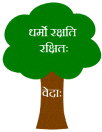Difference between revisions of "Dharmawiki:Main Page/Tomorrow"
| Line 89: | Line 89: | ||
<!-- INTERWIKI STRAPLINE --> | <!-- INTERWIKI STRAPLINE --> | ||
<noinclude> {{noexternallanglinks}}{{#if:{{Wikipedia:Main_Page/Tomorrow}}||}}</noinclude>__NOTOC____NOEDITSECTION__ | <noinclude> {{noexternallanglinks}}{{#if:{{Wikipedia:Main_Page/Tomorrow}}||}}</noinclude>__NOTOC____NOEDITSECTION__ | ||
| + | {{DISPLAYTITLE:<span style="position: absolute; clip: rect(1px 1px 1px 1px); clip: rect(1px, 1px, 1px, 1px);">{{FULLPAGENAME}}</span>}} | ||
Revision as of 02:03, 24 July 2018
Today's Featured ArticleVedas and Dharma (वेदाः धर्मः च) Vedas (वेदाः) and Dharma (धर्मः) have been the pillars on which Sanatana Dharma (सनातनधर्मः) stood ground since time immemorial. That Vedas are the source of all Dharma (in moral, social, religious, judicial, and spiritual sense) is irrefutably advocated by all authoritative texts of our Bharatiya Samskrtika Parampara. The word Dharma (धर्मः), for which no word of any language can be substituted, is used erroneously and loosely in the sense of sanctioning various unrighteous deeds in the name of changing society and times by different people all over the globe. ...View More Related Links Vaidika Vangmaya (वैदिकवाङ्मयम्) Vaidika Vangmaya (Samskrit : वैदिकवाङ्मयम्) means that literature which is "associated with the Vedas". Vaidika literature includes the ancillary and subsidiary texts associated with the Vedas which have come into existence to clarify and understand the Vedas. Thus over a period of time, different explanatory shastras evolved to explain the subtle concepts presented in Vedas and they are included in under the Smriti literature.The following headings cover the topics discussed under Vaidika Vangmaya
|
|
Foundational Articles*Veda Vargeekarana (वेदवर्गीकरणम्) Veda (Samskrit : वेदः) is regarded as revealed scripture, self-explanatory and self authoritative, according to many traditional Indian scholars. वैदिकसूक्त-s || Vedic Suktas (Collection of Mantras) and मन्त्र-s || Mantras are "seen by" or "revealed to" and only spoken by the ऋषि-s || Rishis (seers or sages). These rishis are neither authors of the Mantras nor are they responsible for the contents of the Mantras. Thus Vedas are called अपौरुषेयः ॥ Apaurusheya....View More *Shad Vedangas (षड्वेदाङ्गानि) Vedangas (Samskrit : वेदाङ्गम्) literally meaning 'limbs of the Veda' are the six angas or explanatory limbs to the Vedas. They include Shiksha (authored by various rishis), Vyakarana of Panini, the Chandas of Pingalacharya, the Nirukta of Maharshi Yaska, the Jyotish of Lagadha and the Kalpas (Shrauta, Grhya, Dharma and Shulba) belonging to the authorship of various Rishis....View More *Varnashrama Dharma (वर्णाश्रमधर्मः) The principles of varna (samskrit : वर्णः) and ashrama (samskrit : आश्रमः) are founded upon the principles of Purushartha (पुरुषार्थः) viz. dharma (धर्मः), artha (अर्थः), kama (कामः), moksha (मोक्षः) that are the foundation of India’s culture. These Purusharthas together with varna and ashrama sum up the entire principles of Indian culture....View More |
|
Latest Articles*Shad Darshanas (षड्दर्शनानि) The Six Darsanas or Shad Darshanas (Samskrit : षड्दर्शनानि) include the intellectual and philosophical discussions of concepts found in Bharatiya siddhantas (सिद्धान्तः । theory). Indian Philosophy has been intensely spiritual and has always emphasized on practical realization of truth as against the Western Philosophy which is essentially an intellectual quest for truth....View More *Arjuna Vishada Yoga (अर्जुनविषादयोगः) Arjuna Vishada Yoga (Samskrit: अर्जुनविषादयोगः) is the commonly given name to the first chapter of the Bhagavad Gita. As the name suggests, it is the chapter in which Arjuna pours out his agony....View More *Utsarga (उत्सर्गः) Utsarga (Samskrit : उत्सर्गः) literally means ‘letting go’. This happens when a property or item is dedicated or released for general public use. Pratishta and Utsarga involve acts of foundation of temples and dedication of wells, tanks, parks for the benefit of the public. Such works of public utility have been highly recommended from very ancient times....View More |
Why Dharmawiki |
|
Dharma Point of View Articles
Contact Us and Request Account at dharmawiki2018@gmail.com
|
|
Contemporary Discussions*Hindu and Bharatiya (हिन्दू एवं भारतीय) हिंदुत्व से अभिप्राय है हिन्दुस्तान देश के रहनेवाले लोगोंं के विचार, व्यवहार और व्यवस्थाएं | सामान्यत: आदिकाल से इन तीनों बातों का समावेश हिंदुत्व में होता है| वर्तमान में इन तीनों की स्थिति वह नहीं रही जो ३००० वर्ष पूर्व थी | वर्तमान के बहुसंख्य भारतीय इतिहासकार यह समझते हैं कि हिन्दू भी हिन्दुस्तान के मूल निवासी नहीं हैं | उनके अनुसार यहाँ के मूल निवासी तो भील, गौंड, नाग आदि जाति के लोग हैं | वे कहते हैं कि आर्यों के आने से पहले इस देश का नाम क्या था पता नहीं | जब विदेशियों ने यहाँ बसे हुए आर्यों पर आक्रमण आरम्भ किये तब उन्होंने इस देश को हिन्दुस्तान नाम दिया | आज भारत में जो लोग बसते हैं वे एक जाति के नहीं हैं | वे यह भी कहते हैं कि उत्तर में आर्य और दक्षिण में द्रविड़ जातियां रहतीं हैं | हमारा इतिहास अंग्रेजों से बहुत पुराना है | तथापि हमारे तथाकथित विद्वान हमारे इतिहास के अज्ञान के कारण इस का खंडन और हिन्दू ही इस देश के आदि काल से निवासी रहे हैं इस बात का मंडन नहीं कर पाते हैं| यह विपरीत शिक्षा के कारण निर्माण हुए हीनता बोध, अज्ञान और अन्धानुकरण की प्रवृत्ति के कारण ही है | वस्तुस्थिति यह है कि आज का हिन्दू इस देश में जबसे मानव पैदा हुआ है तब से याने लाखों वर्षों से रहता आया है | हिन्दू जाति से तात्पर्य एक जैसे रंगरूप या नस्ल के लोगोंं से नहीं वरन् जिन का आचार-विचार एक होता है उनसे है | लाखों वर्ष पूर्व यहाँ रहनेवाले लोगोंं की जो मान्याताएँ थीं, मोटे तौर पर वही मान्यताएँ आज भी हैं|...View More |
Useful Links |
|
Featured Video |


